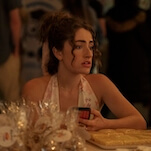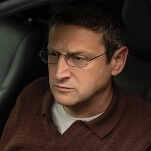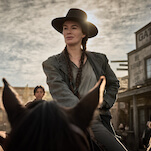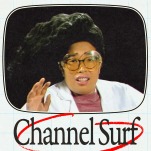EB: You know, it's purely a personal thing. There are some directors who are not as comfortable working with actors or intimate situations and are amazing at spectacle, and then there are some that are good at both. And then there are some, like Steven Spielberg, who you think of as a big spectacle director, but that's not what he's focused on, So I think there are misperceptions out there. Guys like James Cameron, who was very supportive of this project—Jim and I worked together on The Abyss, and he's been a 3D evangelist also—he's just scarily good at everything, so I don't know what to say about him.
AVC: Did you learn things by watching directors on big effects movies, in terms of what to do or not do with actors?
EB: Oh yeah, and in two fields: I've watched bad ideas being done, watched train wrecks happening on giant movies, and I've watched really good ideas carried out, and seen how magically, it was the smartest thing anybody did. So I brought a lot of that experience, in that reading what was on the page, or when designing a sequence, I would optimize it for the most efficient way to shoot, because I knew "If the camera is a foot to the right, it's going to be $10,000 more. If I have it here, and have the actors look this way, it will be efficient." All that stuff, I brought into the mix from experience. It's a very good learning experience to be on the front lines and watch how other people have solved issues.
AVC: Speaking of Pearl Harbor…We've heard a lot about what it's like to work with Michael Bay from an actor's perspective. What's he like from the POV of a visual-effects coordinator?
EB: Michael and I get along great. He's a very smart guy—he sizes you up instantly. He instantly evaluates, at the first opportunity, are you useful to him, are you bringing something to his movie, are you making him look good? And if you are, he treats you very well, and if you're not, he has no time to waste on you. And so he sized me up as a guy who was doing a good job, helping him, helping his movie, who knew what I was doing and wouldn't put up with any bullshit, and that's the kind of person he likes. So we get along great. He's a really fun guy, you know? The stories you hear are probably true, but in my case, it was a very good collaboration.
AVC: Apart from working with actors on Journey To The Center Of The Earth, what else did you have to do that you had never done before as a director?
EB: The things that I hadn't done as a director are the simple stuff, two people sitting and talking. I'm used to "Where will the aliens be, and when will things blow up?" It's like, "How do I make this scene interesting? It's just two people sitting and talking!" And there's an energy level in Journey that for me was important to never let down. And yet story-wise, you have to have these moments where the characters pause, or they discuss something the audience needs to hear. For me, structuring those scenes so we didn't lose the momentum of the overall story was something I hadn't done before, and it was really interesting. I mean, I did it the way I had always seen everybody else do it, and it worked. Luckily, I had some really good editorial people who took my footage, who I asked "I think I've covered this scene, I think I've got it, let me know." The great thing about working digitally is, you see your dailies the same day you shoot them, and I could say "Yeah, I don't need any more, this is great," and it worked. For me, it was the easy stuff I hadn't done before—the hard stuff for most directors was all kind of familiar territory.
AVC: Your first time working with actors, was it more of a challenge dealing with Brendan Fraser, who has a lot of experience with films like this, or directing somebody new to it?
EB: Working with Brendan was a delight. He sized me up as a guy who knew exactly how to deal with the technology and could help him with his amazing talent of being one of those actors who could play against nothing and really sell it. I saw in him the world's best actor at that kind of stuff. And I've worked with a lot of famous, award-winning actors who find it's just not comfortable; it's not in their repertoire to be able to pretend to have a conversation with someone who isn't there, or whatever. Brendan's the world's best at it, so we just helped each other look good, I think. Josh [Hutcherson] had done some of this, and Anita [Briem] hadn't, but I spent 25 years working with actors in visual-effects situations, so I really understand what they need to have on the set with them to react to, so they're completely in the scene. So I brought something to the situation, whether it was a little mini-movie of how a scene's going to play, or I had blowups of artwork made, and I would put them in the environment and say "This is what it's going to look like." I insisted on two weeks of rehearsal prior to shooting, and we went through all the sequences. It was just the three of them, myself, and a script supervisor, and I said "Let's talk about everything that's going on," so by the time they got on the set, they had already been through the movie together as a little group. They were remembering the scenes, which was so much easier than walking cold onto a stage with bluescreens and giant electronic cameras, and trying to find the sequence. That was challenging, but there were no problems. They were all really good actors; that helped a lot too.
AVC: How do you rehearse a scene where people are basically screaming in terror for five minutes? And then how do you take that onto the set and make it fresh after six takes of "You're still terrified and screaming?"
EB: It's a great question. What you do is, you rehearse the mechanics of it; you don't rehearse it at the energy level. I'd say "Give me this at 50 percent," and they'd go, "Ahhh. We're still falling." That kind of thing. And even though they're not yelling or throwing their all into it, you can still figure out the dynamics of the scene and block it, and then when they do it at full force, it's fresh still. And you don't overshoot it, you get it in a couple of takes, because they will get tired.
AVC: You talked at the Q&A; last night about how you made the movie by shooting with a camera with two lenses, basically shooting two films three inches apart, and then compositing it down to 2D for editing and expanding it back to 3D. How does "compositing it down" work?
EB: We just took one lens' output. We edited one eye.
AVC: Then you just digitally match all the edits on the footage from the other eye?
EB: Yeah. In the electronic editing systems, what happens is, every scene has a name and frame numbers, so you edit the one eye you're looking at, and then in theory, you press a button that says "The edit list of this entire scene, apply it to the matching eye." In reality, somebody is staying up late for weeks making it happen, but that's the basics of what's supposed to happen. Then you have two versions of the movie three inches apart, and we have two projectors and a special new technology from Sony that puts two datastreams together onto one tape. So you can take the tape, put it in a machine, and it looks just like it does in the theater.
AVC: In a lot of the shots, there's a distinct two-level visual effect, where the foreground and background are separated into flat planes.
EB: Yeah, like a ViewMaster.
AVC: Right, or a Magic Eye picture. Does the camera create that effect based on distance, or do you go in digitally to separate it?
EB: What happens is, I decide when I'm shooting it how much depth to record in the scene, and that's physically done by taking the lenses and moving them farther apart or closer together. For example, there's a scene where they're climbing a mountain in profile, and you see glaciers and things, and a lot of layers of depth. For that, I would have the lenses further apart, because I want to really let the audience see, in a ViewMaster-type way, all those layers. A close-up of somebody's face would be really distracting, because we don't normally see people's faces with our eyes on the sides, so I bring the lenses closer together.
AVC: What else is involved in directing a 3D movie that isn't involved in directing a 2D movie?
EB: Well, 3D is one more tool, like sound, like color, so as a director, you can choose to really embrace and use that—I try to, in every scene, think about how I'm going to shoot it so it's interesting to look at in 3D—or you can ignore it, and it happens to be just one more thing that the camera's doing. As long as you shoot a movie that's comfortable to watch in stereo, you haven't hurt anything. But if you don't know what you're doing, you can do it in a way that hurts your eyes; you can go cross-eyed because everything's too close, or wall-eyed because everything's too far apart. So on a technical level, you want to shoot things at a range that's comfortable to watch no matter what. And you want to design sequences or block the actors in a way that you're taking advantage of the depth. Like the scene with the glow-birds flying around, I put a lot of thought into having the ability to place the actors in the screen space and then have the birds feel like they're flying in the theater space. Those are conscious choices that I get to use that would be really pleasing when people see the film.
AVC: At the Q&A; last night, someone asked what the film will look like in 2D on DVD, and you and Brendan both went "Uhhhh…"
EB: We were kidding. [Laughs.]
AVC: But did you think about what your shots would look like in 2D, at home or in theaters without 3D technology?
EB: No.
AVC: Not at all?
EB: No. It's impossible to do that. Like I was saying, the danger with 3D is eyestrain. If you make the movie so it looks good on a full-size screen, it's going to be fine on a smaller one. There's no problem there. There are some schools of thought where you re-render all the scenes, especially in a computer-graphics movie, to make the depth even greater 'cause you know it's going to go onto a small screen. But that's financially impossible; you can't afford to do that. I don't think anybody can. Because my movie's live-action, it's not even an option.
So what I think will happen when the movie comes out on home video—there'll probably be the colored-glasses version initially, because that can be seen on any TV. And then I'm hoping that they'll also include the digital version, so that if you have a special adapter for your TV set, and the glasses like we had last night, you'll be able to see it in normal color in 3D. Some TV sets already on the market are 3D-enabled, but no one has a product, so they're not advertising them. But that's like the next thing.
AVC: Is it a selling point for the studio that you're putting out a movie people can't pirate by filming it in the theater?
EB: Yeah. They like that. It doesn't really affect me, but piracy is something the studios are very concerned about, and the fact that you can't just camcorder this movie is something that makes them very happy.
AVC: So what's next for you?
EB: Because the word of this movie has already gotten out, I've gotten some scripts from producers who are interested in exactly this kind of thing—big, fun movies, probably in 3D. So I'm meeting with studios right now and hoping to jump into one after this one opens.
AVC: Do you think you could go back to doing effects on other people's movies, having been a director?
EB: I enjoy being a director, but I love doing effects too, so if I can direct a movie that has special effects, it's the best of both worlds. And if someone needs me to help out on something, I like doing that too. Right now, I'm focusing on directing.
AVC: 3D has always been sort of a novelty in moviemaking, a gimmick at most. Do you think the ease of digital moviemaking and projection will make it more common and more of a mainstream thing?
EB: I think that if everyone is smart, and they keep it as a tool and not just a gimmick, audiences will accept it. If five slasher films and three pornos are the next things to come out in 3D , it's going to really reinforce the gimmicky, "If your movie isn't very good, then add 3D to it" feeling. But I'm hoping there are enough big-budget, classy 3D movies coming out that we'll keep seeing it as a really great A-list opportunity.








































